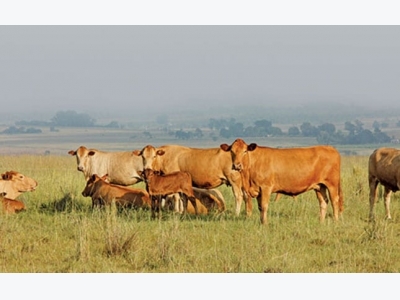5 signs your cattle are on heat

For the most profitable results, get to know the basics of cattle reproduction and herd management.
The heat cycle starts again about two months after calving. Photo: Wayne Southwood
A heifer reaches puberty between six and 15 months of age, depending on the breed, but she should not be used for breeding until she is at least 18 months old. Servicing her too soon will impair her growth and result in decreased fertility and milk yield.
A cow normally comes on heat every 21 days on average. Ruttishness can last between three to 24 hours, with the average time being 16 hours. The heat cycle starts again about two months after calving.
A cow’s sexual cycle is not seasonal. However, a rest period can occur in winter and spring if there is insufficient feed or weather conditions are unfavourable.
Signs of heat
Ruttishness in a cow is normally obvious. Here are some of the signs:
- She is restless, and lows as if looking for her calf. She sometimes wanders away.
- She urinates only a little at a time and sniffs the air.
- Her eyes have a wild expression and she flicks her ears actively.
- She licks other cows, tries to mount them and allows other cows to mount her.
- Her vulva is swollen and mucous sometimes hangs from it. The tail hangs next to the vulva and is slightly lifted.
Successful Servicing
Artificial insemination is commonly used in dairy cows, while group breeding with one or more bulls per herd is usually used in beef cattle. Bulls and cows must be in good condition before servicing, and should be treated against external and internal parasites. Bulls should be tested for fertility and servicing ability.
Herd management
In the case of beef cattle, place every bull in a camp with its own herd of 30 to 40 cows, if possible. Remove the bulls from the herd of cows after two to three months. In the case of dairy cattle, take ruttish cows to a bull or apply artificial insemination.
Related news
 Beef cows: meeting their nutritional needs
Beef cows: meeting their nutritional needs Beef farmers should take care to match the nutritional needs of a cow to her production cycle to ensure optimal fertility rates, expecially when forage quality
 Managing feed and breeding in replacement females
Managing feed and breeding in replacement females Heifers, first-calvers, maiden ewes and first-lambers need to be managed properly to reduce risk in terms of productivity versus production costs
 Biological farming ensures dairy farm’s success
Biological farming ensures dairy farm’s success Their pasture-reared dairy herd is thriving and can be directly traced to the operation’s original 17 cows